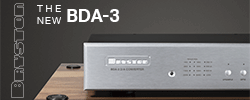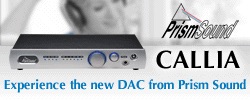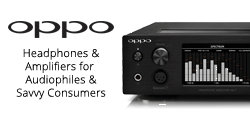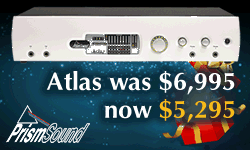Brevis
Price: $999
Likes: audio quality, battery
Dislikes: 96 kHz native limit
by John Gatski
In my nearly 30 years of reviewing audio products, Shure Inc. has never made a product that was not high quality. Microphones, of course, wireless systems, headphones and now a series of portable D/A converter/headphone amplifiers.
Such is the case of the compact, battery powered SHA900 headphone amplifier/DAC. This well made, great sounding unit sports a 24-bit D/A converter-to-HP amp circuit that is quite detailed sounding and as accurate as more expensive portable DAC/HP units.
Although the SHA900 comes to us via a company known for its professional audio products, the SHA900 (and its big brother, the KSE1500 with electrostatic ear buds), can be used with smart phones, tablets, computers, etc. via USB digital input, or simply take the smart device’s onboard source analog output and go analog in.
A pro recording, or a golden eared musician who likes to record and edit could use it for editing and recording tasks via a music production laptop. A hi-fi buff can mate the SHA900 with the analog or digital outputs (via Micro USB to USB or Micro USB to Apple Lightning connector) to smart phones, tablets, computer, etc. However you plug into it, the SHA900 is guaranteed to make the music sound good.
Features
The $999 SHA900 features a Cirrus Logic D/A chip/headphone amplifier and a Cirrus Logic A/D to convert analog input signals to digital (for reconversion to analog). The unit is quite simple with a small LED display, top-mounted rotary control which doubles as a menu navigator/selector control. On the left side is a power button and a hold button. The bottom houses a selector switch for USB or analog input. The line IN and HP outputs are on the top panel.
The unit is powered by a lithium battery, which can go as long as nine 10 hours for a signal using the DSP and up to 20 hours if using a purely analog signal chain hours depending on how much gain you use and the sample rate of the music.
The SHA900 offers pro-caliber, hi-res sonic quality with excellent stereo width and depth. It is a revealing HP monitoring set up for headphone hi-fi buffs, seasoned audio pros and talented musicians who like to do their own music production.
Speaking of sample rates, the Shure can output 24-bit audio, up to 96 kHz sample rate. I thought the SHA900‘s 96 kHz limit was puzzling — since high-res music played from smart devices, computers, etc. is played up to 192 kHz sample rate or higher. As of early 2017, nearly all high-quality DACs, consumer or pro, can natively decode at least 192 kHz and even higher sample rates.
After my inquiry about the reason for the SHA900‘s limited sample rate ceiling, a Shure product specialist told me that the period from design to finished product was a lengthy process (several years) and that the 96 kHz was the norm when the design started. By the time the SHA900 hit the market, he said, the 192 kHz sample rate had become the norm.
According to a Shure, “we were aiming to make a portable product, and many of the portable sources out there have a limited sample rate. Apple's iOS is limited to 96k, and iTunes 48k. Many of the higher end DAPs don't require an external DAC, but can definitely still benefit from the functionality of the amplification via the analog input.”
I am happy to report that the SHA900 is up there with the best of the $1,500 and lower-priced portables — in terms of resolution and space. With the EQ bass setting, in the flat position, the SHA900 is very accurate.
Though the 96 kHz limit is inherent in the SHA900, you can still play 192K audio and higher sample rate music, as most software players can downsample to the highest rate of the connected DAC. For example, the USB Audio Player Pro Android software player played audio from as high as 24-bit/384, downsampled to the Shure’s maximum 96 kHz rate. And it still sounded good. It is better to have DACs decode native sample rates, as opposed to down sampling, but minimal resolution loss is often not perceived when the downsample process is effective.
Perfect control blend
To give compatibility for all sorts of players, the Shure SHA900 features onboard low/high-gain control, limiter and an adjustable EQ with a loudness boost, de-ess mode and user-defined custom memory EQ settings.
 |
| Small, but informative display |
To access the various menus, you simply push the volume control twice to access the Menus window then rotate the knob to select the Equalizer, Audio or Utilities folder. The EQ settings are in its namesake folder; they include Flat, Low Boost (extra bass), Vocal Boost, Loudness, De-ess and four memory defined EQ presets that the user enables.
The Audio menu allows for Low/High Gain, Limiter and indicates the maximum sample rate. The Utilities Menus include adjustments for Display, Battery Info, Firmware/Hardware Info, Factory Reset option and a “Disable Charging” mode for use with the USB input.
The setup
It took a while to get a review sample of SHA900, but it was worth the wait. Having briefly auditioned one almost two years ago at a professional Audio Engineering Society Expo, I liked what I heard from a basic pair of Shure HPs. I was curious to hear them with my own cans.
I utilized the SHA900 in a variety of playback scenarios with different headphones and players:
•As a headphone amp/DAC with an Android phone and Android tablet, using the USB Audio Player Pro software player, playing hi-res music from HD tracks.
•As a headphone amp/DAC with an Apple Macbook Pro (using the USB connection) and listening to hi-res music from HD tracks and my own hi-res dubs.
•As headphone amp/DAC for monitoring audio recording, mixing and the mastering of several hi-res 24/96 tracks in the recording/editing program Audacity (the best one you can get for free IMHO).
Headphones included a pair of Oppo PM-2 planar magnetic HPs, Shure top-of-the-line SRH1840 (no bigger fan of these headphones than me), the AKG K702 Anniversary HPs, and a pair of Sennheiser HD650s.
I connected the SHA900 to an HTC-One M8 Android phone and played an assortment of hi-res tracks through the USB Audio Player Pro, my favorite smart device hi-res audio player. You need an USB OTG cable to allow the Android system to transmit the audio from the smart phone/tablet via USB, but it works well.
The audition
Using my AKG K702 Anniversary HPs, I played a 24/96 dub of the Warren Bernhardt — So Real, a DMP SACD from 2001. The first track, “Autumn Leaves,” has substantial dynamic range with a big ole Steinway piano and luscious drum cymbals. A good headphone playback system allows the listener to hear the “space” in between the instruments. The portable Oppo HA-2 HP amp/DAC, for example, and the iBasso DX-80 HP amp/DAC/player all do a great job relaying that space from the aforementioned track.
Ergonomically, the SHA900 is easy to operate. I did not open the manual at all, except for looking at the specs. Battery life was phenomenal — with up to 9 hours between charges.
I am happy to report that the SHA900 is up there with the best of the $1,500 and lower-priced portables — in terms of resolution and space. With the EQ bass setting, in the flat position, the SHA900 is very accurate. Yet, it is not harsh sounding like I have heard in other HP amp/DAC combos. The Shure cannot be faulted on its audio quality. It is audiophile all the way.
On classical guitar music from the Gene Bertoncini — Body and Soul SACD 24/96 PCM dub, the intricate string picking, combined with an airy recording room made for a smooth, percussive, broadly spaced stereo image. Again I was impressed with the SHA900.
 |
| SHA900 decoding hi-res from a smart phone |
On the Mercury Living Presence, Complete Bach Cello Suites — Janos Starker, I definitely could hear the complex string textures from the cello recording in all that glorious space that the performance is noted for. The cello tone was full, yet I could pick out the room reverb cues, Mr. Starker’s subtle breathing and low-level bow noise.
All the headphones performed well with the Shure SHA900. The AKG K702 and Shure SRH1840, with their big, open image impression, the Sennheiser HD650's tight, pulsing bass and the Oppo PM-2's planar-magnetic ribbon warmness were revealed with plenty of volume. The high-impedance AKGs had to be turned up a bit more to get it louder, but it played loud enough for me.
Computer playback mate
Being that Shure is a pro audio company, I naturally put the SHA900 into music editing duty. I edited a number of classical guitar samples that I had made in hi-res 24/192 with the Audacity record/edit program on my Macbook Pro.
I simply connected the headphone amp to the computer via the USB cable and selected the Shure SHA900 as the player in the Mac Audio settings (and in Audacity’s audio settings). I also had to set the Mac’s audio output to the 96 kHz sample rate since the SHA 900 only does 96 kHz max sample rate. Any music I played through the SHA900 was downsampled to 96 kHz.
 |
| Shue SRH1840 is a revealing mate for the SHA900 |
With the Shure SHA900 inline and active, I could easily make my edits, as well as QC the recording’s quality via the SHA900 and the HPs of my choice. With an accurate set of phones, like the Shure SRH1840, the SHA900 audio exhibited a definite pro-caliber sonic quality with lots of stereo width and depth. I could hear all the bits of room echo and subtle string squeak, etc. It is a revealing HP monitoring set up for both seasoned audio pros and talented musicians who like to do their own music production.
Ergonomically, the SHA900 is easy to operate. I did not open the manual at all, except for looking at the specs. Battery life was phenomenal — with up to 9 hours between charges. The only niggle I have with the SHA900 is the previously mentioned lack of the native 192 kHz sample rate decode. If Shure would remedy the sample rate, the SHA900 would be dang near perfect.
The verdict
The SHA900’s $1,000 price tag is definitely an audiophile price, but I do not see it as overpriced. It is very well built and the audio is top notch. The better the headphone, the better it sounds — and the DAC conversion is first rate as well. Airy, wide and deep soundstage with abundant detail.
After much consternation about the sample rate limit, I ultimately decided to give the SHA900 an Everything Audio Network Stellar Sound Award. It indeed sounds that good. In fact, it surpasses a few standalone home audiophile DAC/HP amps that I have heard.
John Gatski has been evaluating consumer, audiophile, home cinema and professional audio gear since 1988. In 1995, he created Pro Audio Review, and he has written for Audio, Laserviews, Enjoy The Music, The Audiophile Voice, High Performance Review, Radio World and TV Technology. Everything Audio Network is based in Kensington, Md. Articles on this site are the copyright of the ©Everything Audio Network. Any unauthorized use, via print or Internet, without written permission is prohibited. John Gatski can be reached via email: everything.audio@verizon.net


























































































